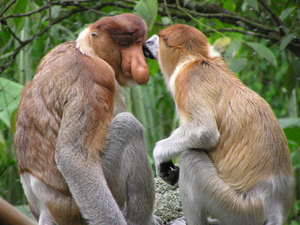Physical Characteristics
The proboscis monkey is 29 to 30 inches long with a 26 to 26 ½ inch long tail. It weighs about 46 pounds. The most distinct physical feature of the proboscis monkey is the nose of the adult. It is long and hanging. It is believed that it might play a role in attracting mates. The female’s nose is much smaller then the male’s but still larger then compared to other species. The noses of the young are small. Young are born with a blue face and dark fur. As the proboscis monkey gets older its fur lightens to pink and brown with red around the arms and shoulder and gray arms, legs and tail. The scrotum of the male is black. The penis is red. This species has partly webbed feet.
Behavioral Characteristics
The proboscis monkey lives in groups. Groups are called troops and tend to consist of a single male and 6 to 10 females and their young. The male is the protector of the group. When threatened he honks loudly, bares his teeth and waves his erect penis at the enemy.
Life Cycle
The proboscis monkey does not have a very restricted mating season. It may breed anytime between February and November. Mating is initiated by the female and she will continue to initiate it even after she has become pregnant. To initiate mating the female purses her lips, shakes her head from side to side and presents her hindquarters to the male. The female can produce a single young every year. The gestation or pregnancy lasts 166 days. Birthing usually happens during the night. The female sits on a branch in order to give birth and soon after the infant is born the mother will eat the placenta. The proboscis monkey female will nurse her young for about 7 months, however the young does not become independent until about 1 year old. The female becomes sexually mature at about 4 years old. The male does not become sexually mature until about 7 years old. The highest recorded lifespan of the proboscis monkey is 23 years in captivity.
Diet
The proboscis monkey eats mostly fruits, seeds, young leaves and mangrove shoots. It will also eat some invertebrates like caterpillars and insect larvae. Between January and May it will eat more fruit then leaves then from June to December it will eat more leaves then fruit.
Habitat
The proboscis monkey is fond in south east Asia on the island of Borneo near water in habitats of lowland rainforest and mangrove swamps. It also lives in coastal regions of the island.
Conservation Status
The proboscis monkey is classified as endangered on the IUCN (International Union of Conservation of Nature and Natural Resources) red list of threatened species. Its population has declined by 50 to 80 percent in the past 30 years. Habitat destruction and hunting continue to threaten the species leading to assured further decline in the future.
References:
Animal: The Definitive Visual Guide to the World’s Wildlife by, David Burnie and Don E. Wilson
http://animaldiversity.ummz.umich.edu/site/accounts/information/Nasalis_larvatus.html
http://www.iucnredlist.org/details/14352/0




